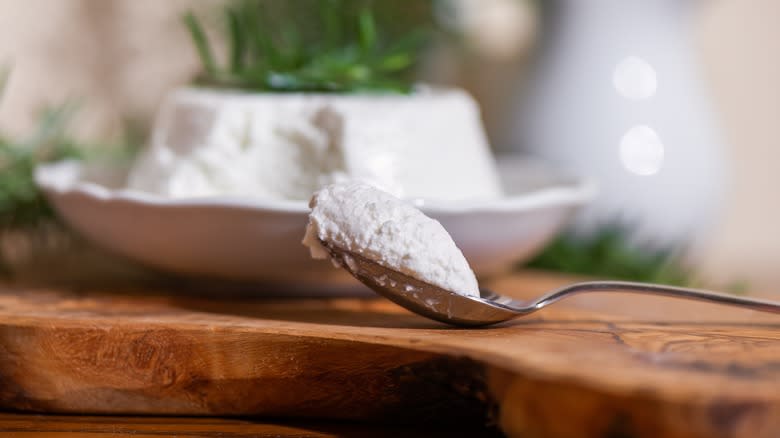A Dollop Of Ricotta Adds An Ultra-Creamy Touch To Risotto

Contrary to popular belief, starch is a desirable aspect of rice used in many culinary traditions, like mango sticky rice, rice pudding, and savory rice cakes. Risotto is an indulgently creamy rice dish from Italy that coaxes the natural starches out of arborio rice with the help of butter, wine, and broth. A dash of heavy cream and grated parmesan are the traditional final touches that enhance risotto's creaminess. If you thought risotto couldn't get any richer, a dollop of ricotta will launch risotto into the next realm of decadence.
Ricotta is a soft, fresh cheese known for its mild, milky flavor and velvety, whipped texture. The taste is amenable to the earthy, savory, and salty notes in classic risotto. As a popular ingredient in lasagna, you may already know that ricotta pairs well with the saltiness of parmesan and an array of classic Italian herbs. It also complements the sweet undertones from the dry white wine and savory richness of the starch-heavy arborio rice. Plus, as an Italian-born cheese itself, ricotta will only add authenticity to this famous Northern Italian rice dish.
Along with its versatile flavor, ricotta is especially treasured for its unique consistency that is both smooth and grainy, bestowing risotto with a nuanced creaminess.
Read more: 13 Unexpected Ingredients To Elevate Lasagna
How To Add Ricotta To Risotto

You can incorporate ricotta into risotto at various points in the cooking process, and each provides different yet extravagant effects on the texture. Ricotta has the ability to maintain its semi-solid consistency even when heated, but it will also break down into a sauce when combined with warm broth or cooking liquid.
Right as the arborio rice has absorbed the final bit of broth, you can stir in a spoonful of ricotta at the same time you add the cream and parmesan cheese. The starchy liquid created by the rice acts the same way as reserved pasta water does, transforming it into a creamy sauce.
Alternatively, you could spoon a dollop of ricotta onto the bottom of an empty bowl or plate before adding a portion of risotto, then stir to combine. This will only partially break the ricotta down, making your risotto creamy with a delightfully grainy finish. That said, if you don't stir it long enough, you might not notice the ricotta until you're halfway through the risotto.
If you'd rather enjoy ricotta in its whole, solid form, you can add a dollop over a plate of risotto as a final touch. A dollop on top of risotto also amps up its visual appeal. You can graze your spoon over the ricotta before plunging it into the risotto, giving you a full range of textural contrasts.
Read the original article on Tasting Table.

